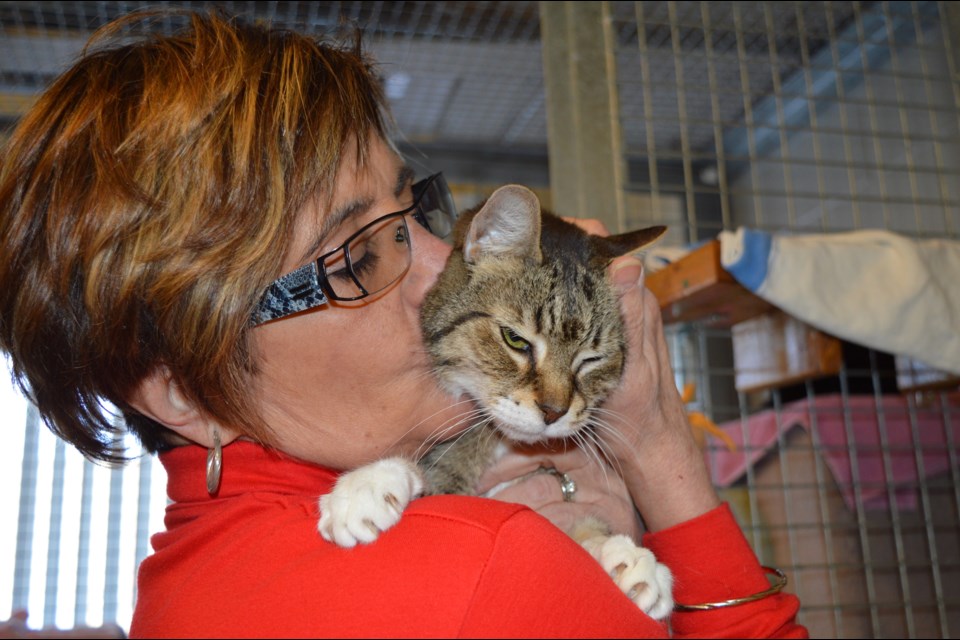Being cute has its advantages, but when it comes to adopting an adult cat, there are a lots of reasons to say yes, says Furry Friends’ PetSmart adoption centre coordinator Mel Hinch.
“A kitten is irresistible. They sell themselves,” said Hinch, who has made it her 2017 goal to get more of the no-kill shelter’s adult cats a home.
“Almost all our cats – that’s between 150 and 200 at any time – are adults. We have every single age, all ages.”
In the Furry Friends shelter, the adult cats range in age from just a year to 15. Many are young adults, ages four, five and six. They have a decade or more to explore, play and cuddle.
“People don’t look at an older cat. They think they’ll get sick. That’s usually not true.”
She’s determined to fight the discrimination tooth and nail.
“We have older people in their 80s in good health. Some societies toss away their seniors. They feel they have no value, but they do. We feel the same way about our older cats. They have lots of experience.”
There are those whose owners have moved away and who have had to surrender their long-time companions. There are others who have spent much of their adult lives interacting with the shelter’s volunteers while awaiting what Hinch calls their “furr-ever home.”
“I compare them to antiques. They are very valuable. Our older cats have lots of experience. They’ve been nicked and scratched, but they’re in good health.”
Sammy, 14, is a prime example. He loves to cuddle, curl up and nap. He’s a quiet, content soul.
Hinch notes, when you’re dealing with adults, you know the personality and the habits of whom you’re about to adopt.
“With the case of a stray cat whose been missing the safety and love of a home, they become even more loving once they are back in a home of their own,” said Hinch, who is working on getting to know each and every cat so she can write not only biographies, but accurate descriptions of the characters who are looking for love.
Her biographies read like personal ads, with more than a dash of humour thrown in, along with a lot of honesty.
Not yet at the shelter is Zoe, a 16-year-old tabby, can’t move to Alberta with her family in late February. In good health, she enjoys peace and quiet and Furry Friends is trying to help her find a new home.
“She has been bullied by other cats so has become a loner. Gentle, loves to be petted and brushed. (She is nervous around new people and may sometimes nip,” her bio reads.
Now at Petsmart is a family of older cats, whose human family could no longer care for them.
“The entire fur family is friendly affectionate and healthy. Jacob is the shy one; he sticks pretty closely to his younger brother, Hammer,” said Hinch.
The mom and sister are a closely knit pair as well, and Furry Friends is looking for two homes – one for the boys, the other for the girls.
In human years, the mom – named Baby – is 72, while her daughter Misty is 68. Her sons Jacob and Hammer are 64 and 44 – so they have lots of years to play and cuddle.
The shelter’s statistics show kittens continue to appeal to the public. In 2016, of the 579 cats adopted, 322 were kittens and 257 were adults.
Hinch is working to make that ratio 50/50 and she’s armed with more reasons to consider an adult cat.
Because they’re not kittens, they’re not hyperactive and they don’t play in the litter box. Just as kids might like to throw water in the school washroom, kittens can kick around the litter, leaving more than a trail of litter and sometimes a little hockey puck of debris outside the box.
Adult cats have also mastered the art of self-care and grooming. That means they’re likely to maintain themselves. Not only does that mean they look and feel good to the touch all the time, they are less likely to spit up hairballs, those pesky wet logs that are cold to the foot.
Young adults and more mature cats, too, also know the rules of living with humans.
“They know not to nibble your toes or walk across your head when you are in a deep sleep,” said Hinch.
“(They) tend to want to spend more time with you, whether it be in your lap, beside you on the couch or in their bed near you. They don’t have the need to play as much, but they do have the need for lots of your love.”



